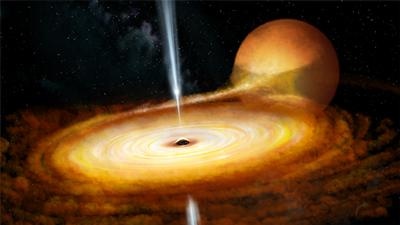Oct 14 2019
Led by the University of Southampton, an international team of astronomers has made use of high-tech cameras to make a high frame-rate movie of an enlarging black hole system at a level of detail never witnessed before.
 Illustration of the MAXI J1820+070 Black Hole (Image credit: John Paice)
Illustration of the MAXI J1820+070 Black Hole (Image credit: John Paice)
Through the study, they discovered new clues to comprehending the nearby surroundings of these mysterious objects. The researchers have described their study in a new paper published in Monthly Notices of the Royal Astronomical Society.
Black holes have the ability to devour a neighboring star and form massive accretion disks of material. In this case, the impact of the strong gravity of the black hole and the material’s own magnetic field can result in the release of quickly changing radiation levels from the system as a whole.
It was possible to detect this radiation in visible light using the HiPERCAM instrument on the Gran Telescopio Canarias (La Palma, Canary Islands) and in X-rays using NASA’s NICER observatory on-board the International Space Station.
The explored black hole system, named MAXI J1820+070, was initially discovered in early 2018. It is located just about 10,000 light-years away, in the Milky Way. Its mass is roughly equal to that of seven Suns, where the mass is collapsed down to an area with space smaller than the City of London.
These systems are challenging to investigate, as their distances make them extremely faint and very small to see—even the Event Horizon Telescope, which in recent times captured a picture of the black hole at the center of the M87 galaxy, would not be able to achieve it.
However, the NICER and HiPERCAM instruments allow the scientists to record “movies” of the varying light from the system at more than 300 frames per second, capturing fierce “crackling” and “flaring” of X-ray and visible light.
John Paice, a graduate student at the University of Southampton and the Inter-University Centre for Astronomy and Astrophysics in India, was the study’s lead author who presented these results and created the movie.
The movie was made using real data, but slowed down to 1/10th of actual speed to allow the most rapid flares to be discerned by the human eye. We can see how the material around the black hole is so bright, it’s outshining the star that it is consuming, and the fastest flickers last only a few milliseconds—that’s the output of a hundred Suns and more being emitted in the blink of an eye.
John Paice, Study Lead Author and Graduate Student, University of Southampton
Scientists also discovered that decreases in X-ray levels occurred together with a rise in visible light (and vice versa). Furthermore, the fastest visible light flashes were found to appear a fraction of a second after X-rays.
Such patterns implicitly expose the existence of unique plasma, very hot material in which electrons are stripped away from atoms, in structures deep within the clasp of the gravity of the black hole, otherwise very small to resolve.
This is not the first time this discovery took place; a split-second difference between visual and X-ray light has been observed in two other systems accommodating black holes. However, it has been seen never before at this level of detail. The international team involved in this research has been at the leading edge of this field for more than a decade.
Dr Poshak Gandhi, also from Southampton, detected the same fleeting time signatures in the two earlier systems as well. Remarking on the importance of these outcomes, he said, “The fact that we now see this in three systems strengthens the idea that it is a unifying characteristic of such growing black holes. If true, this must be telling us something fundamental about how plasma flows around black holes operate.”
Our best ideas invoke a deep connection between inspiralling and outflowing bits of the plasma. But these are extreme physical conditions that we cannot replicate in Earth laboratories, and we don’t understand how nature manages this. Such data will be crucial for homing in on the correct theory.
Dr Poshak Gandhi, Researcher, University of Southampton
Black hole crackling and flaring violently
Video credit: University of Southampton